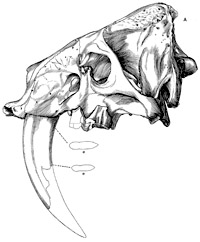Museum, University of Nebraska State

Bulletin of the University of Nebraska State Museum (1924–2023)
Date of this Version
1931
Document Type
Article
Citation
BULLETIN 25 VOLUME I DECEMBER, 1931
Abstract
The remains of no less than eight fossil musk-oxen are already known in Nebraska, of which one is preserved in the Museum at Hastings, Nebraska, and seven in the State Museum at Lincoln. This is a large number to be recorded in anyone state. As late as 1891 authors wrote that but two examples of musk-oxen were known in the United States, one from Kentucky, and one from Arkansas, if, indeed, they be valid species. Now that pioneer days are well behind this commonwealth, and that there is a growing sentiment for exploration and proper display of the State's resources, it is a safe assumption that many more will be found and recorded. That the remains of creatures so thoroughly boreal should be found far south of the arctic circle, their natural, barren, frigid, and rocky range, is ascribable to the great glacial age. These animals move~ southward with the vast, invading ice sheet, and followed it northward in its grand retreat. They frequented the borders of the great ice fields and it is not mere coincidence, then, that their relics occur here, and further southward. In a like manner, during this age of frigidity, other mammals migrated far south of their natural habitat. The remains of walrus have been reported as far south as New Jersey and even Georgia, the caribou in New England, and Symbos, an extinct musk-ox, has been trailed from Alaska south to Arkansas, and in Europe to southern France.
Included in
Entomology Commons, Geology Commons, Geomorphology Commons, Other Ecology and Evolutionary Biology Commons, Paleobiology Commons, Paleontology Commons, Sedimentology Commons

